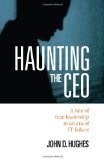Ideally, it’s because such novels, at their best, can do the following:
- provide a degree of engagement and entertainment in making their points
- provide a realistic insight, in a “show not tell” kind of way, into what motivates the typical players in these business scenarios,
- help all factions (inside and outside IT) come to see the other side’s perspective and arrive at deeper understandings of common problems and disagreements.
- allow the CIO to hand the novel to his or her CEO or CFO and trust that everyone’s reading of it will help reach common ground in how to collectively and collaboratively approach the company’s goals.
Haunting the CEO is a slim, readable novel that depicts a CIO, Brian, who is faced with a new CEO, Jim, who wants to make changes in order to turn around the company’s declining results. Jim tells Brian that he expects IT to drive business growth and profitability, as well as innovation. He keeps Brian on, provisionally, while telling him in no uncertain terms that he needs to see action and results sooner rather than later. But Brian is a techie, through and through, and doesn’t really have an inkling of how to begin.
Enter Carol, Jim’s CIO from his previous company, who has agreed at Jim’s request to serve as informal volunteer mentor to Brian. As they meet over coffee and lunches, she walks Brian through examining his current practices and IT staff, challenges his thinking, and ultimately helps him both to achieve greater insight into what he needs to change in his own behavior as a leader, and to take concrete action to turn around IT in general at the company.
You can tell this novel was written by someone who’s been there, done that.
This novel of IT distinguishes itself enormously from FruITion in particular in one main way: you can tell it was written by someone who’s been there, done that, rather than delivering an abstract solution from on high. John Hughes’ foreword directly admits as much: discussing his 30-year career, he writes, “my mistakes are woven throughout the stories, characters and events you’re about to immerse yourself in.” True to one of the core leadership traits he espouses in the book, humility, the author’s own words here foreshadow CIO Brian’s own path to learning what he needs to change and leave behind (in himself and in his staff) as he turns around IT for the greater benefit of the company.
Haunting the CEO is filled with small and large insights about leadership in general, and IT leadership in particular. As with other small business books with great wisdom (Kenneth Blanchard’s The One Minute Manager comes to mind), it’s easy to pick on its occasional oversimplification of complex issues, or to quibble about the vagueness of the necessary steps to follow in order to echo Brian’s success. But above all, the book reasonably and accurately depicts, in broad brush ways, the necessary “mental transformation” (to use its own words) required for an entrenched technologist to become a true business leader.
Personally, I would have preferred that the book show much more of Brian’s changed interactions with his business peers, and would point out the unfortunate aspect that in the end, the changes Brian effects appear to come mostly through his firing of about 10% of his IT staff. For that reason and more, I’d be a little leery of whether this book fulfills the criterion I established up front: wanting to be able to hand this book to my CEO so that he or she can get deeper insight into IT and its interrelationships with the rest of the business. The danger behind doing that with Haunting the CEO is that the standard image it paints of the CIO as the entrenched technologist is fading, so to some degree the book may be making points that reinforce and thus risk perpetuating a near-obsolete (and damaging) stereotype.
All that said, this is a fine novel of IT, and well worth the time spent reading it and absorbing its many lessons.
Next time, I’ll talk about the last of the three novels of IT on my initial list, Adventures of an IT Leader, by Robert D. Austin, Richard L. Nolan, and Shannon O’Donnell.
Lagniappe:
- Caron Carlson, “A novel look at the CIO’s need to lead”
-
Elliot Ross, “Book Review: Haunting The CEO”


[…] Next up: two more novels of IT that I believe show a (much) more even-handed, useful, and insightful approach. […]